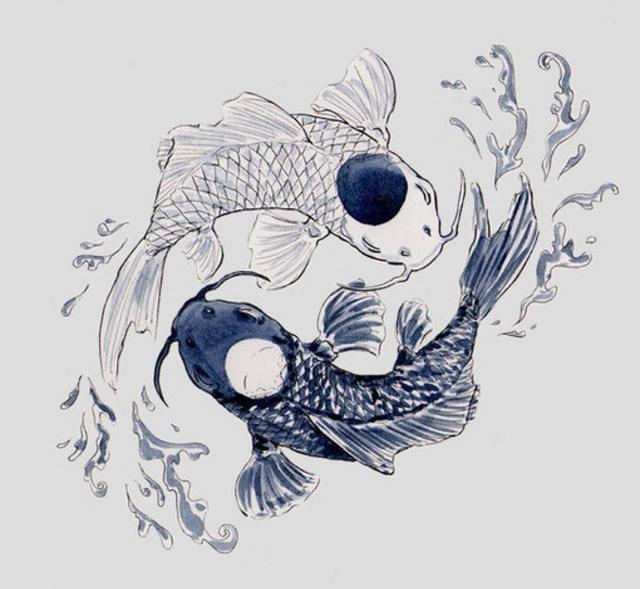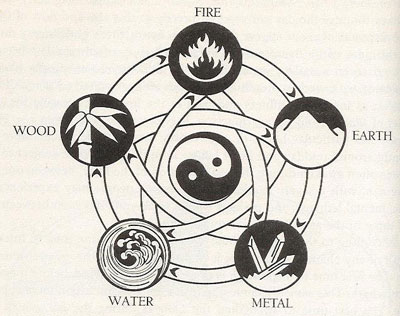The Theory of the Five Phases (Wǔ Xíng 五行) or Five Processes, sometimes called of the Five Elements, arose from the observation of the cycles of nature as a way of predicting or ordering certain phenomena.
Origin:
The Theory of the Five Phases appeared during the Zhou 周 Dynasty (1122-249 BC), possibly as a way of representing seasonal changes that affected agricultural production, and underwent some important changes throughout history.
The Five Phases are: Wood (mù 木), Fire (huǒ 火), Earth (tǔ 土), Metal (jīn 金) and Water (shǔi 水).
In the beginning, these Phases were related to the cardinal points and the Earth was placed in the center as a neutral element:
East corresponds to spring; it is the beginning of the cycle, where the sun rises and nature regenerates. These characteristics are related to the element Wood. South is related to heat and summer; these characteristics correspond to Fire. The West is autumn, when the sky is clear and clean; corresponds to Metal, whose greatest virtue is purity. The North is related to the cold of winter and the Water element, whose main property is to descend. The Centre is neutral and corresponds to Earth. It is on earth that the changes take place.
We must bear in mind that this theory, originated in China, refers to the country's climatology, where the south is hot and the north is cold, summer is rainy and in autumn the sky is clean and clear.
Zōu Yǎn 邹衍 and the Theory of Five Phases
An important thinker who combined the Theories of Yīn-Yáng 陰陽 and the Five Phases was Zōu Yǎn 邹衍 (305-240 BC). This philosopher lived during the Warring States period (戰國時代 Zhànguó Shídài), when the so-called Hundred Schools of Thought (諸子百家 Zhū Zǐ Bǎi Jiā) developed. This period (475-221 BC) was characterized by an empire divided into many states that fought with each other for taking full control of the territory; it was a violent and chaotic time that lasted more than two centuries. When Zōu Yǎn lived, it was clear that this time would only end when one of the states succeeded in imposing itself on the others and taking full control; thus different thinkers emerged who tried to offer advice to the rulers on how to achieve this.
Zōu Yǎn applied the Five Phase Theory to human society and history, because he believed that the latter, in the same way as Nature, followed predictable cycles. According to him, only the ruler who was able to understand and predict these cycles would be victorious over the others.

Current theory:
Later on, the Earth became integrated as an element in the cyclical order, giving rise to the theory we know today. This change was gradual and this new theory was not systematized until the 4th century. With time, the theory was introduced in Traditional Chinese Medicine (TCM), assimilating the components of the human body to different elements and explaining its operation in accordance with the laws that regulate the relations between the Five Phases.
These relationships can be divided into those that are considered normal, which include the relations of generation and control, and those that are considered abnormal, which include the relations of exploitation and opposition.
Generation relations (shēng 生):
The relations of generation are those by which one element or phase generates and nourishes another, and constitute an infinite cycle without beginning or end. In this way, Wood generates Fire; Fire nourishes Earth; Earth feeds Metal; Metal nourishes Water; and Water makes Wood grow.
The relations of generation are also called 'Mother-Son relationships', where Mother is the element that generates and Son the one that is generated. For example, Earth has Fire as its mother and Metal as its son.
Control or inhibition relations (kè 克):
They are those by which one element inhibits or controls the growth of another, dominating it to keep it within its normal levels. Thus, Wood controls Earth; Earth inhibits or channels Water; Water calms Fire; Fire controls Metal; and Metal dominates Wood.

Graphic representation of the generation and control cycles between the Five Phases.
The cycles of generation and inhibition reflect the normal relationships in nature and in the human body, and their alteration implies an ecological or pathological change.
Exploitation relations:
They refer to excessive control by a strong element to a weak one, without letting it grow or stay within its normal limits. This situation of exploitation may be due to the hyperactivity of the controller or to the weakness of the controlled.
Opposition relations:
When an element is not allowed to be controlled by its controller, it is said to be 'opposed'. Thus, the opposition relation refers to an alteration in which the element that should be controlled happens to inhibit the one that should control it. For example, in a normal situation Earth controls Water, but if Water passes to control Earth an opposition relation is established in which Water inhibits Earth. This situation can be due to weakness of the controller or excess of the controlled.
The abnormal relations of exploitation and opposition are related to each other, since when there is an excess of an element, for example Water, it opposes its controller (Earth) and at the same time exploits its controlled (Fire).
In TCM, the theory of the Five Phases is applied in the analysis and classification of organs and energy meridians and in the study of their relationships according to the normal cycles of generation and control, in the study and diagnosis of pathologies according to the exploitation and opposition cycles, and in determining treatment.

One thought on “Wu Xing: The Five Phases Theory”
Muy acertado.
Las relaciones yin-yang y la teoría de los cinco elementos son la base del diagnóstico en medicina tradicional china.
Pienso que para entender las artes marciales chinas y su entrenamientos tradicionales debemos profundizar en esta forma de pensar.
Es el vedadero tesoro de esta tradición (lo que aporta dr diferente al mundo de las artes marciales).